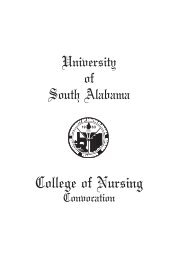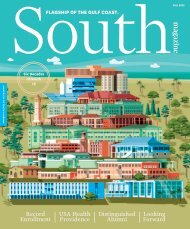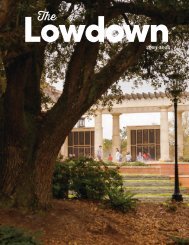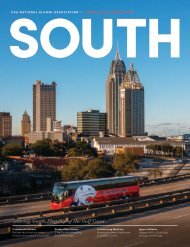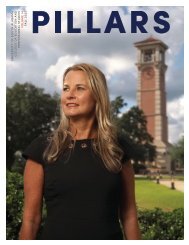JOURACA_SP_2017
Create successful ePaper yourself
Turn your PDF publications into a flip-book with our unique Google optimized e-Paper software.
Evaluating Expression of N. tabacum<br />
<strong>SP</strong>41a in Arabidopsis<br />
Adam Stern<br />
If a map was constructed of everything we know<br />
about cell-cell interactions in floral tissue some<br />
areas would include rich detail of specific molecules<br />
involved in signaling cascades (i.e. the SI<br />
system in Brassica that prevents self pollination).<br />
Whereas, other areas would simply read "here be<br />
dragons". Sadly, one of the blank areas of the map<br />
would be signaling pathways involved in pollen<br />
tube guidance through the transmitting tract during<br />
fertilization. This project is the first phase of a<br />
larger project to map cell-cell signaling between<br />
floral tissue and the pollen tube during fertilization.<br />
As the pollen tube travels through a number<br />
of different tissues on its way to the ovule, this<br />
system provides the opportunity to also study context<br />
specific cell-cell interactions. The specific<br />
goal of this phase of the project is to develop a<br />
molecular tool kit and associated protocols for the<br />
rapid evaluation of tissue- and species- specificity<br />
of gene promoter regions. To this end it is important<br />
to understand that a gene contains information<br />
related to more than just the gene product.<br />
A gene also has specific regions that provide information<br />
about when a product is made and where it<br />
is deployed. Three regions involved are the promoter,<br />
the product and the localization signal. The<br />
promoter is responsible for recruiting transcriptional<br />
machinery to read the gene and generate a<br />
corresponding mRNA. The protein product coded<br />
by the gene, is subsequently delivered to the locale<br />
of its function via a localization signal. This research<br />
project is focused only on the evaluation of<br />
promoter sequences that are responsible for gene<br />
expression in floral tissue. The center piece of the<br />
promoter evaluation tool kit generated here is a<br />
custom constructed plasmid that allows for integration<br />
of a promoter and a product, via Golden-<br />
Gate<br />
Department of Biology<br />
Mentor: Tim Sherman<br />
Gate digestion/ligation. Candidate promoters can<br />
be found in literature related to gene expression<br />
of specific tissues. As an example, <strong>SP</strong>41a is a<br />
transmitting tract specific mRNA found in N.<br />
tabacum and is a promoter under evaluation here.<br />
The method for inserting a promoter of interest<br />
into the test plasmid was to design a set of primers<br />
for the sequence that include a IIs endonuclase<br />
site coded to insert the digestion product<br />
into the plasmid in the proper configuration. The<br />
IIs endonuclase site is added to the sequence via<br />
overhang PCR allowing for integration from<br />
PCR product. For this project, <strong>SP</strong>41a and 35s<br />
promoter regions in tobacco and Arabidopsis<br />
plants were evaluated using the same procedure<br />
and enzymes to construct the plasmid changing<br />
only the promoter used. It is hoped that the system<br />
being developed here will allow for rapid<br />
evaluation of tissue specific promoters across a<br />
large number of plant species and will allow for<br />
the development of a standard library of promoters<br />
enabling the construction of tools that can<br />
facilitate the mapping of cell-cell communication<br />
pathways by targeting molecular probes to specific<br />
tissues and gene expression pathways.<br />
40




